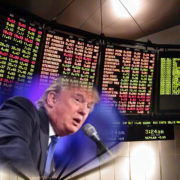TRUMP AND EMERGING MARKETS
As originally appeared in The Jerusalem Post on January 18, 2017.
With the inauguration of President Trump right around the corner, clients have been asking me how they should reposition their portfolios. My answer, as I have written before, is to pretty much do nothing. As long as you have an appropriate asset-allocation for your own financial situation, there isn’t much need to make any fundamental changes. But for those who want to invest a bit more strategically it pays to think about how the Trump rhetoric and soon to be policies will impact certain sectors or geographic regions of the global economy. In this article I’d like to focus on one of my favorite investment destinations: emerging markets (EM).
Conventional wisdom
Most of the analysis that has been published since the election warns investors to stay far away from these markets. They point to two central reasons to be scared. They warn of higher US interest rates which are bad for EM currencies, and potential protectionist economic policies that could especially harm economies like Mexico and China.
Hello?
Where I think these analysts are mistaken is that they aren’t looking at the reason for higher US interest rates. Rates don’t move up in a vacuum. The reason that markets are pricing in higher rates is due to the expectation that after 8 years of sluggish growth, Trump and the Republican controlled congress will pass corporate tax cuts, roll-back onerous regulation and get the economy moving again. This should actually benefit EM.
Shamaila Khan confirms my thesis in the AB Global blog. “But here’s the thing: why rates rise matters. In this case, markets are clearly pricing in faster growth and higher inflation, and a stronger US economy should boost economic activity elsewhere, emerging markets included. It’s especially good news for EM commodity producers, who stand to benefit from any further stabilization or rise in the prices of oil, gas, metals and other natural resources. A period of gradual Fed rate increases and improving growth can coincide with tighter EM yield spreads and rising returns. On the other hand, the past several years of extremely low growth and rates in the US and other developed economies have hurt emerging economies and EM assets.”
Be selective
Investors need to be selective in which EMs to invest in. While Mexico and China could be hurt do to trade policy and even a potential trade war, other countries like Brazil and South Africa may be poised for strong growth.
As Kahn writes, “What’s more, rising rates aren’t a big problem for emerging markets today. That’s because many countries, including South Africa, India, Indonesia and Brazil, have spent the past few years chipping away at their external imbalances and reducing large current account deficits. The adjustment was painful, but it’s paying off in the form of stronger economic fundamentals, and it leaves EM assets less vulnerable to rising rates and other external shocks. That wasn’t so in 2013, the last time US Treasury yields spiked suddenly. Back then, most emerging markets were on a borrowing binge. When rates rose, the flow of capital into these economies quickly dried up.”
Buy Low/Sell high
The most basic principle in investing. As the U.S. stock market ( as measured by the S&P 500) trades at record levels investors should be on the lookout for markets that have the potential to provide more value going forward. After 5-6 years of relative underperformance versus the US, now may be the time for investors to turn their attention to emerging economies. That means that when you factor in their stronger economic growth, they are flat out cheap vis-a-vis their US counterparts.
There is certainly risk with investing in emerging markets and over the short-term they can be volatile, but speak with your financial professional to investigate whether there is room in your portfolio for this asset.
The information contained in this article reflects the opinion of the author and not necessarily the opinion of Portfolio Resources Group, Inc. or its affiliates. Aaron Katsman is author of the book Retirement GPS: How to Navigate Your Way to A Secure Financial Future with Global Investing (McGraw-Hill), and is a licensed financial professional both in the United States and Israel, and helps people who open investment accounts in the United States. Securities are offered through Portfolio Resources Group, Inc. (www.prginc.net). Member FINRA, SIPC, MSRB, FSI. For more information, call (02) 624-0995 visit www.gpsinvestor.com or email aaron@lighthousecapital.co.il.








